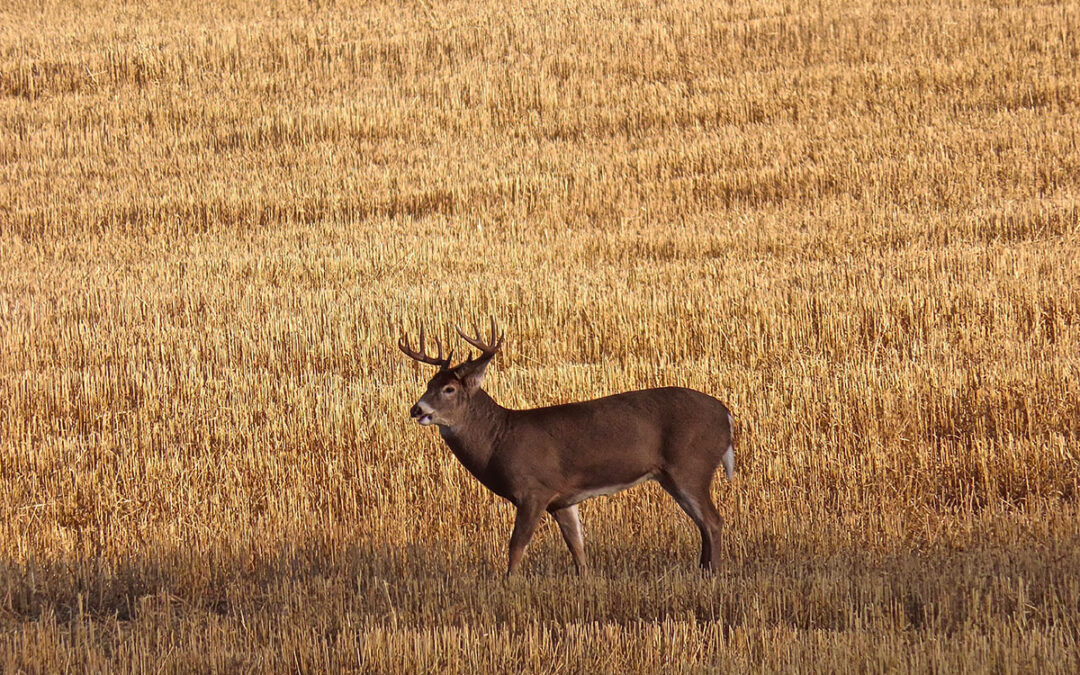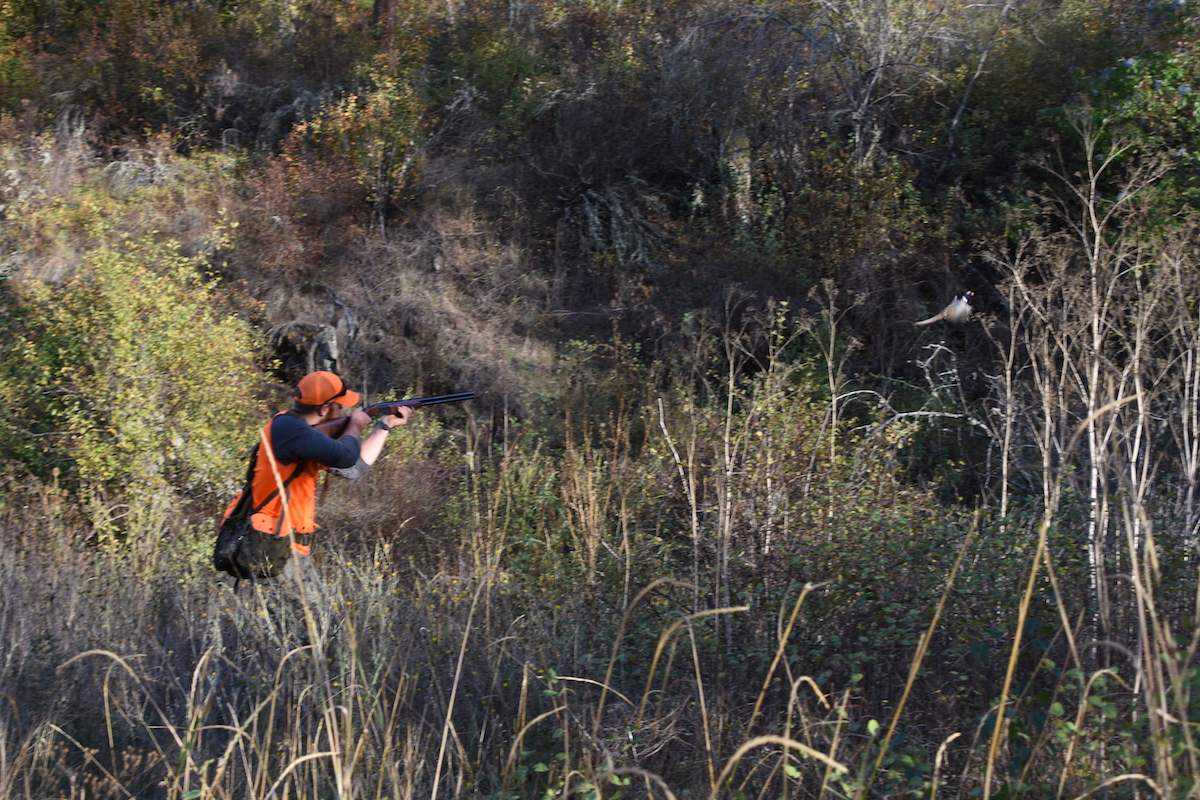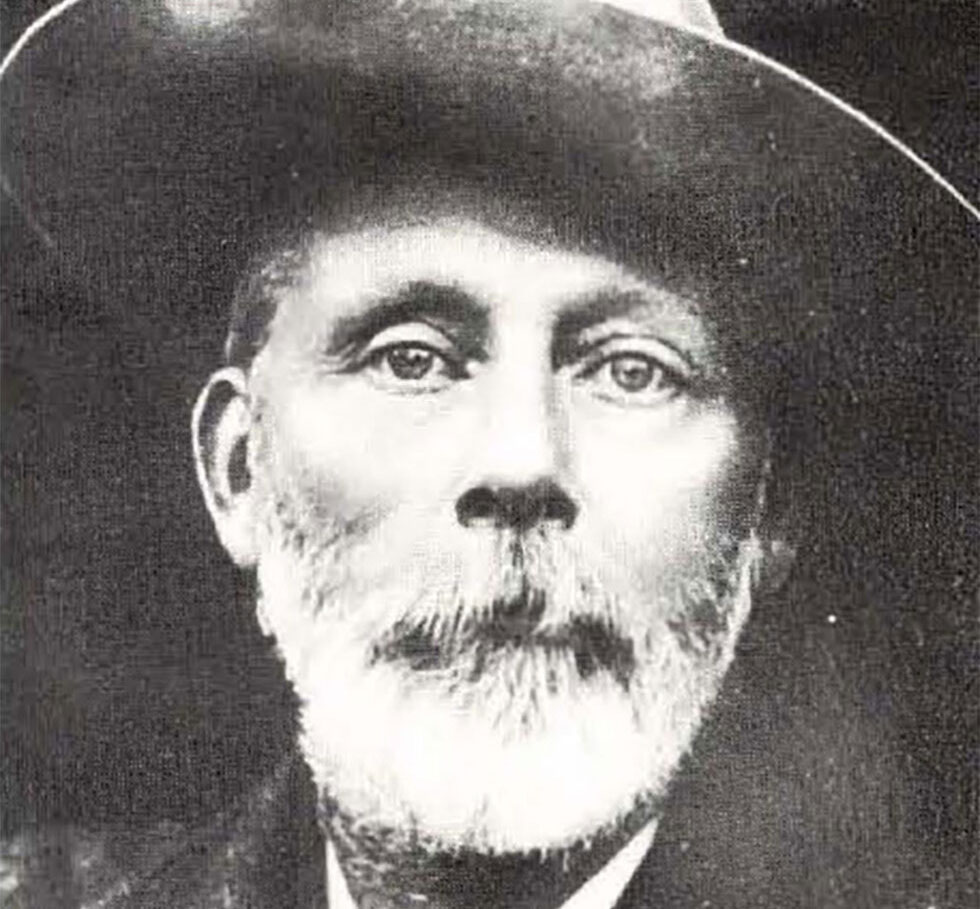Larry Weishuhn recalls how he redeemed himself from the buck that got away.
Of all places! The biggest whitetail buck I have ever seen was standing 50 yards off of Highway 2 between Edmonton to Athabasca. He was huge of body and antler — wide, tall, massive — a dream buck. He stood within the unit for which I had a license, but, unfortunately on property I did not have permission to hunt. For two minutes my guide and I watched the buck of all bucks chase a doe. I looked at his rack from every possible angle except the one I wanted to see most…looking down at those magnificent antlers in my hands. Finally, the doe flitted into a brushy creek bottom. He followed and was gone. This was the buck that got away. The buck of which sparked my redemption.
To this day many years hence, all I have to do to see him is close my eyes and recall those moments! His memory is as vivid as if it occurred minutes ago. Before driving away, I made a promise. Some day I would return to take a huge Alberta whitetail like that one, one whose antlers would surpass 200 Boone & Crockett points!

Weishuhn and Ron Nemetchek with the ancient 8-point Larry took with North River Outfitting the prior to “Redemption.”
The following November, I was back. This time with permission to hunt the property where we had seen the monster. Unfortunately, we did not find the hugely racked buck. We did find an extremely large antlered deer, one whose antlers likely would have surpassed record book minimums. After a long stalk, the buck sensed our approach. I rushed the shot and missed! He disappeared in the Athabasca River bottom before I could shoot a second time.
I returned several times to hunt Alberta with Ron Nemetchek and his North River Outfitting. Ron and I enjoyed some most interesting fun-filled hunts. I took some “nice” bucks, but none compared to the “Highway 2 Monster.” We too, did a couple of “reservation hunts,” which both Ron and I would just as soon forget, as they were comical to life-fearing incidents. To say the least, those hunts were not exactly as they had been represented to Ron and me. It was then Nemetchek and I started talking about a Redemption Hunt.
For several years my schedule did not allow a return hunt with my Canadian friend. However, we kept in touch visiting at the Dallas Safari Club Convention each year and occasional phone calls and emails.
During the 2018 DSC show when I stopped by Ron’s booth he said, “You’re coming to hunt with me in November! I will not take ‘No!’ for answer!” How could I resist or argue? I promised to be in his North River camp the last full week of the Alberta hunting season.
We filmed my 2018 hunt for an episode of “DSC’s Trailing the Hunter’s Moon” television. During the hunt I passed many yearling and two-year old bucks. As a matter of fact, I saw more sub-adult bucks on that hunt than I had ever seen hunting anywhere, including well-managed ranches in Texas. I also saw three truly outstanding bucks soon after losing camera light, but still during legal shooting time. No doubt those three rut neck-swelled mature bucks had antlers measuring beyond record book minimums.
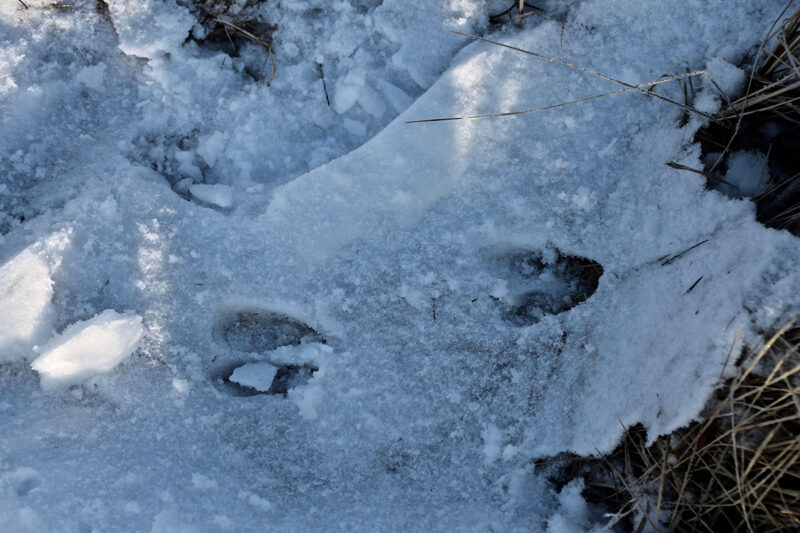
Big tracks in the snow!
Final day, high noon, I shot an ancient 8-point. I was thrilled to have again taken an Alberta whitetail. That evening during dinner Ron proclaimed, “Next year, you are coming back. DO NOT bring a cameraman. If you do, you are not welcome! You could have taken a record book whitetail had it not been for the camera. It’s time for that redemption hunt we have long been talking about, no camera! Come the last week of November, again hear me, NO CAMERA! You and I are going to hunt for a buck that will go 200 or more, nothing smaller!” A handshake sealed the deal.
Later that night over a wee dram of “safe water” in Ron and Maria’s home, a short distance from their hunting lodge, my host pointed to a huge racked whitetail mount. “That one was not the biggest buck I saw that last evening of the season. He’s second choice.” Ron continued, “All our hunters had tagged out and left by mid-afternoon. With a couple of hours left I headed toward the river, toward the same blind you’ve been hunting.” I nodded.
“As I turned the corner, two bucks stood nearly under the blind. That one on the wall, and another that made that buck look like a youngster. The bigger one was easily thirty inches wide and as tall as he was wide, antlers the like of which I had never before seen.” Ron hesitated. “I got so excited I could not raise my rifle. By the time I did, the big buck had walked away. That one up there started to do the same, but stopped broadside just shy of the woods. Knowing the monstrous buck was gone, I decided to shoot the smaller of the two. It was not until I walked to the deer’s side that I realized how big the buck I had just taken was, and how truly huge the one I did not shoot must have been.”
I was mesmerized by Ron’s story and his description of the buck that had gotten away, particularly after seeing how absolutely huge the buck’s antlers were on the one he did take. Ron added, “I often see the biggest bucks last afternoon of the season. When you come, plan on staying through the last moment of the season.” I told Ron I would return without a cameraman, and would indeed stay throughout the last evening. I too, promised not to shoot a buck scoring less than 200.
Prior to heading to Alberta, I sighted in my 300 Win. Mag. Ruger M77 topped with a Trijicon 4-16×50 AccuPoint scope with Hornady’s 200-grain, ELD-X, Precision Hunter ammo. I practiced at distances out to 600 yards and soon felt confident in hitting a deer’s vitals out at that range from a reasonably solid rest. But I hoped my shot would be considerably closer.
I arrived at North River Outfitting’s lodge an hour before dark, just in time to make certain my rifle was still sighted in. It was.

Weishuhn’s view from the blind where he shot his “Redemption” buck.
That night I renewed friendship with Ron’s family and several hunters with whom I had previously shared camps, including Trijicon’s Chuck Wahr. Over a delicious meal we caught up on great stags taken and those that had gotten away. Before retiring, Ron told of a monstrous, wide, non-typical buck he and a hunter had watched for 30 minutes two days before my arrival. Unfortunately, the buck stayed on the wrong side of the fence. Likely, he was still roaming the area.
Our game plan was for Ron and me to hunt together other than when I sat in a blind. Early morning, Ron and I would cruise through properties he had permission to hunt. Mid-morning, I would crawl into a raised and heated blind near the river overlooking harvested fields. Late in the day, Ron would pick me up and we would again cruise during the last hours of the day covering as much country as possible. If we spotted a likely candidate while cruising, we planned to leave the vehicle and stalk to within comfortable shooting distance.
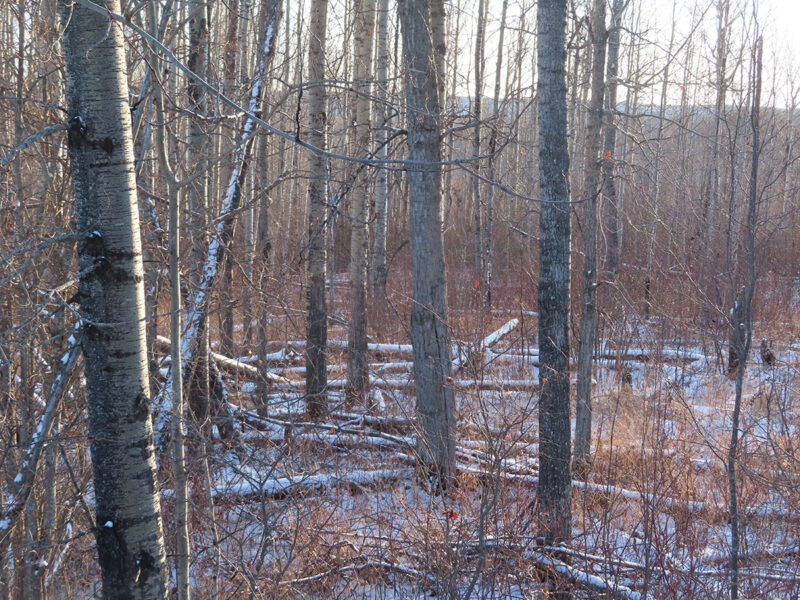
Typical woods near where Weishuhn took his buck.
Hunting this way, we saw a goodly number of deer, especially young bucks, does and fawns. Unfortunately, the weather was rather warm. “We’ll see older bucks when the weather turns cold,” reminded Ron.
I had learned years ago that “cold” by Alberta standards is considerably different compared to Texas standards. In Texas when the temperature drops below 32 degrees Fahrenheit we consider it cold. In Alberta during November when temperatures are single digits and higher, locals consider it a “heat wave.” Alberta’s whitetails seem to think so as well. By late November local deer are “clothed” in their heavy warmth-providing winter coats. They much prefer to “move” in zero and below temperatures.

One of the many young 8-points Weishuhn saw while hunting with North River Outfitting.
The first morning we spotted several mule deer and whitetails soon after we left Ron’s headquarters. Before the morning’s hunt was over we had seen seven bucks with antlers approaching 150 B&C points. I was not surprised based on the great number of yearling bucks I had seen the previous year. Even young bucks grow impressive antlers in Alberta.
Cruising completed, we drove to headquarters, I grabbed a bag filled with snacks, a sandwich and a thermos of coffee. Ten minutes later, Ron dropped me at a blind and promised to return in time to cruise until dark.
I started seeing deer minutes after crawling into the blind. First came three does and two young bucks. A short time later, a nice 8-point walked by. Then a really nice 10-point appeared, likely a two-year-old followed by another equally sized buck. Next came an impressive 10-point with a flyer on his left back tine. His rack likely scored in the 160s. Beautiful buck, but not the one I was looking for. Based on what I saw, if he survived winter and wolves, he would be a “star” in the future. A short time later, Ron picked me up. We spent the afternoon driving property roads and sitting on the edge of a field watching for deer. We found several does and fawns, plus a couple of promising two-year-old bucks.
Essentially we hunted the same way each day. Driving and sitting I saw numerous bucks and does — bucks I would have taken hunting most anywhere else. Two mornings in a row we saw a massive typical 9-point that would have gross-scored well over 170. The other was a typical 10-point that Ron and I estimated scored in the mid-170s. Late the third afternoon, we helped Chuck recover an extremely massive 10-point — Chuck’s biggest whitetail.

Weishuhn checks out a distant whitetail while secreted in a comfortable, heated North River blind.
When not cruising, I sat in a blind. Doing so I saw several bucks scoring up to the 160s as well as many younger bucks, does and fawns. Once again I was tremendously impressed with the great number of buck fawns and yearling bucks I saw. During lulls of deer activity, I called in several red fox and coyotes, then watched them walk away. The foxes in particular where stunningly handsome in their winter coats.
All too soon the last day approached. That morning, Ron and I cruised roads but saw very few deer, even though temperatures had dropped to below zero. Over a quick cup of coffee in camp, we decided I should sit in a blind bordering the river a short distance behind Ron’s headquarters. Possibly later Ron would pick me up and we would spend the last hour cruising.
I had no sooner settled in when I started seeing deer, coyotes and red foxes. The 10-point with a flyer walked by, as did two other 10-points, four 8-points, several forkhorns and 6-point yearlings and numerous does and fawns. There was lot of activity until 1 p.m., then all movement ceased. For an hour not so much as even a raven flew by. Still, something told me to keep the faith. Good would happen this afternoon!
I really wanted to to stay where I was. I just had a “feeling.” Thankfully, Ron must have had that same feeling because he did not pick me up.
Official sundown was 4:12 p.m. As sundown approached, I set my phone where I could see the time. Legal shooting time would end 30 minutes after official sundown. At 3:45 deer started streaming into the field — bucks, does and fawns. By 4:00 I had more than twenty deer in the field feeding.
Just as the sun sank below the horizon, four bucks walked out of the river bottom, each with antlers larger than the previous one. The biggest was an impressively massive 10-point. Moments later, a much bigger buck strode into the field. His tines appeared to be almost a solid wall across the top of his forward swept main beam, extremely massive and tall. Many years of looking at whitetail antlers as a hunter and professional wildlife biologist told me his would score over 200. My heart rate increased dramatically!
I quickly glanced at my clock. At least five minutes of legal shooting time remained.
I brought rifle to shoulder, got the AccuPoint’s little green dot on the buck’s shoulder, then followed him. I let him walk into the center of the field where I planned to pull the trigger. If he did not immediately go down I would have a second shot before he disappeared into the field’s brushy edge.

Larry’s choice for hunting Alberta whitetails: Ruger M77 African in 300 Win. Mag., Trijicon’s AccuPoint scope, shooting Hornady’s 200-grain ELD-X Precision Hunter.
I did not look again at his antlers. I concentrated on keeping the crosshairs on the buck’s shoulder, 150 yards distant.
The buck slowed, I pushed the Ruger’s safety to “fire” and started applying pressure on the trigger. He stopped. I pulled the trigger. Thanks to my muzzlebrake I saw the bullet strike the deer’s shoulder. Keeping an eye on the him, I automatically bolted in a fresh round. I was applying pressure to the trigger, when he fell. I kept crosshairs on the downed buck and waited. He did not move.
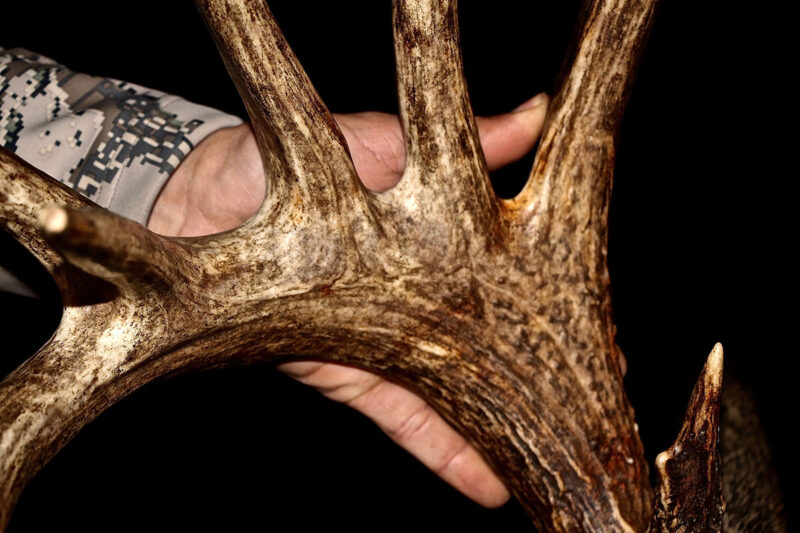
The mass on Weishuhn’s Redemption buck was to say the least, impressive.
Moments later I was at my buck’s side. I could hardly believe his mass and tine length. I counted nine points on his right and six on this left. Basically, he looked like a typical 11-point, plus a long non-typical point on his lower right beam, a point on the inside of the right beam near the tip, and a broken split on left back tine, inside spread was likely 15-inches. Based on tine length and mass, I had no doubt the buck’s rack would exceed 200 B&C points.
I could scarcely believe my good fortune. Commitment to only shoot a buck scoring 200 or more had paid off handsomely! I whispered a prayer of thanks, then tagged my buck before crawling back into my blind to wait to be picked up. I had done it. Redemption for the buck that got away.
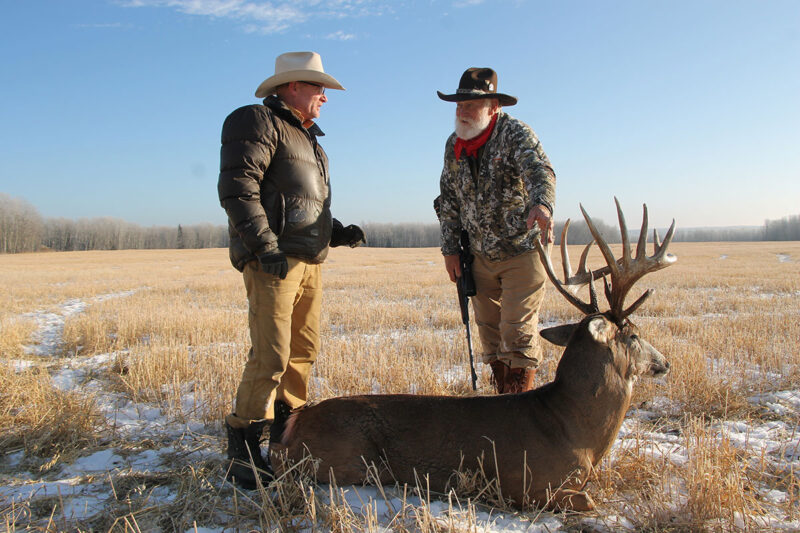
Weishuhn and longtime friend Ron Nemetchek talk over old times that led to Larry’s Redemption buck!
Back at camp, we spent the next hour gutting, admiring and posing my buck for the morrow’s photo session. Bedtime came late. I will admit, I got up three times during the night to walk out to the hanging shed to gaze upon what I consider to be my “best ever” whitetail. The only possible rivals to that title were my first buck and a huge non-typical Coues whitetail I had taken a few years ago in Sonora, Mexico.
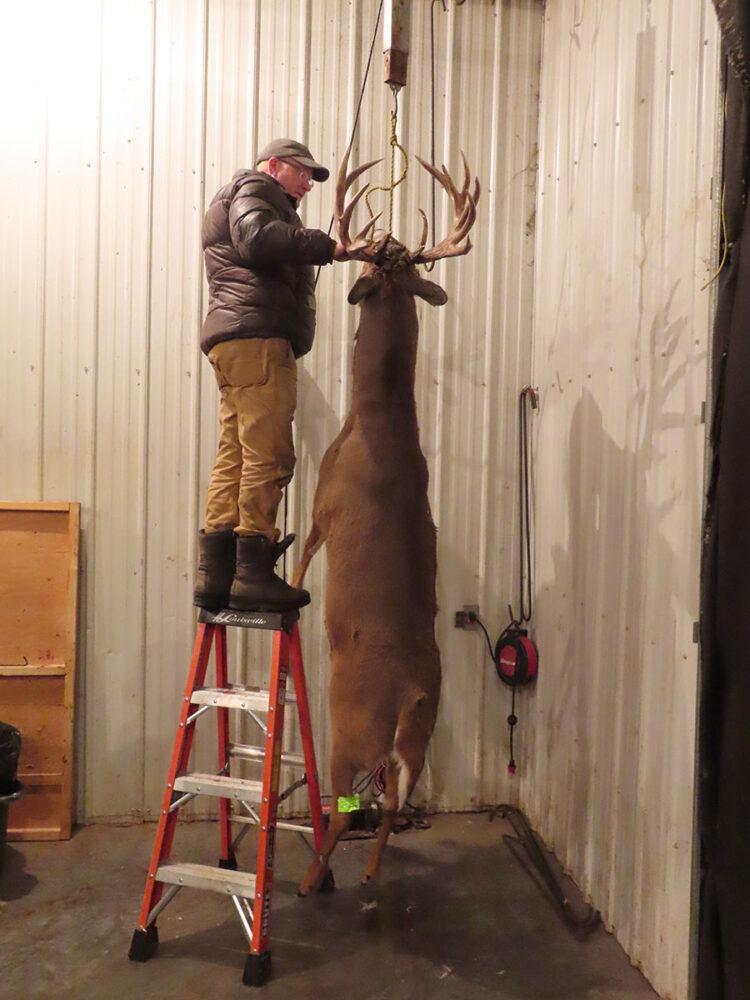
Back at camp in North River’s hanging shed, Ron Nemetchek gets a closer look at Weishuhn’s massively antlered buck.
The following evening, Ron and I gross-scored our “redemption” buck — 212 and change. No doubt, even after the 60-day drying period, my buck’s antlers would exceed the Boone & Crockett non-typical minimum score of 195. Back home in Texas, Jerry Baker officially scored him after I dropped cape and antlers at Double Nickle Taxidermy near New Braunfels.
Great bucks exist on the lands of North River Outfitting. I can hardly wait to return to see what some of the bucks I passed will look like in the future, while Ron and I were hoping for Redemption.
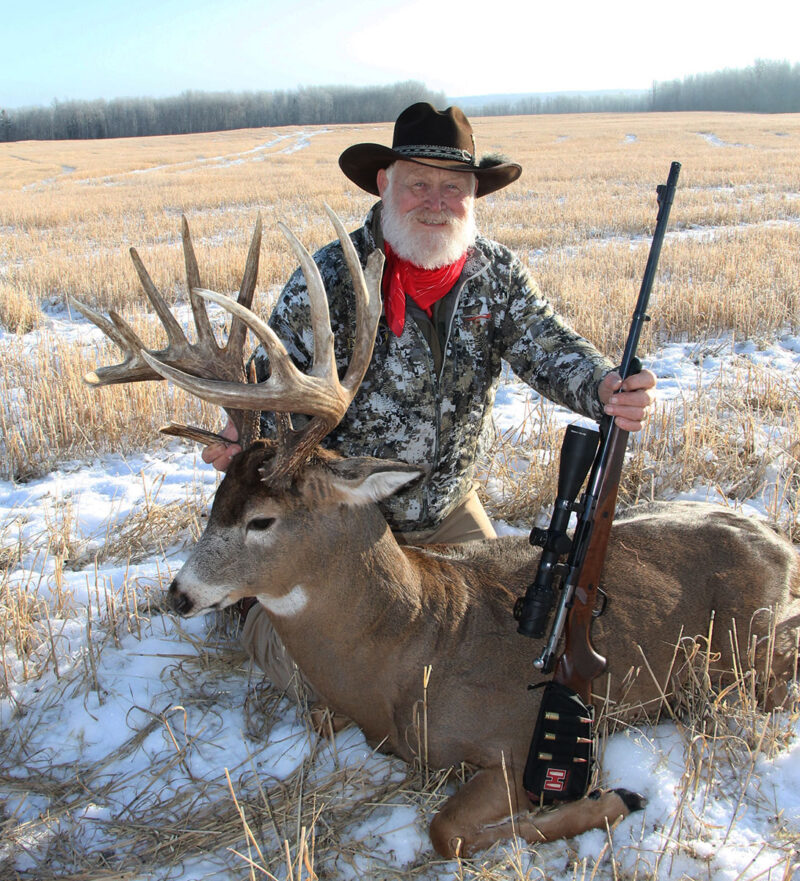
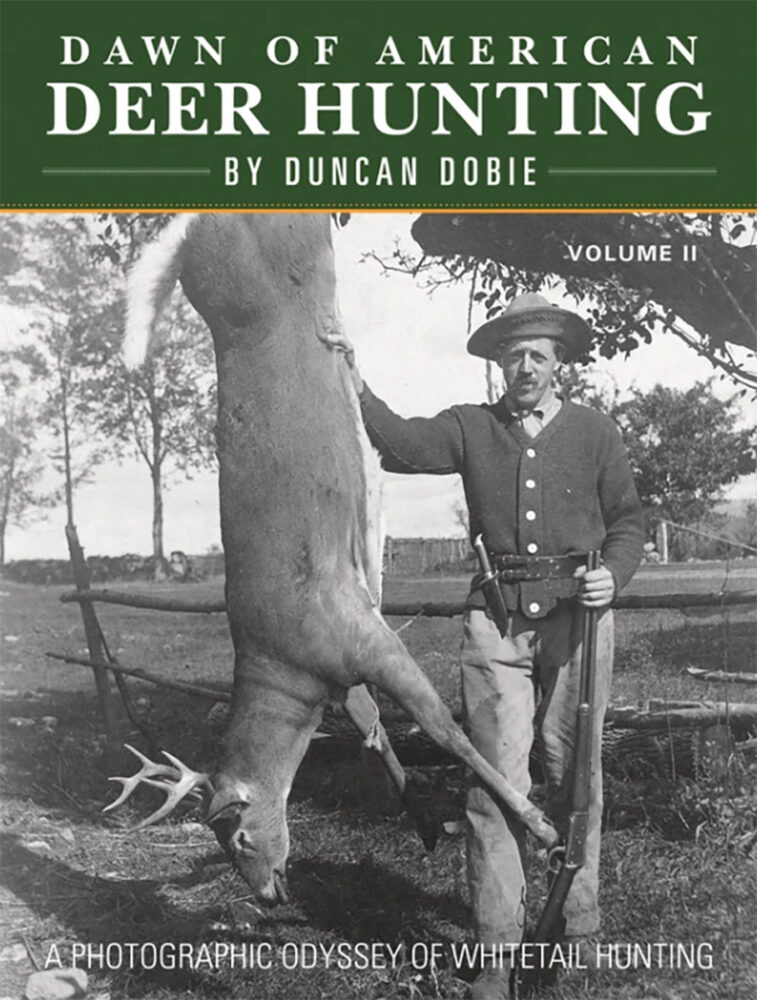 There’s something special about the deer hunters of yesteryear. Seeing rare images of snowy campsites, straining meat poles, classic rifles and the happy faces of the men and women who plied their trade so long ago connects us to those treasured times like nothing else in the world can do. With the enormous popularity of the original Dawn of American Deer Hunting published in December 2015, author Duncan Dobie and Sporting Classics now bring you Volume II, chock full of amazing stories and facts, a breathtaking color section filled with eye-catching whitetail art and nearly 400 stunning black-and-white photos. Buy Now
There’s something special about the deer hunters of yesteryear. Seeing rare images of snowy campsites, straining meat poles, classic rifles and the happy faces of the men and women who plied their trade so long ago connects us to those treasured times like nothing else in the world can do. With the enormous popularity of the original Dawn of American Deer Hunting published in December 2015, author Duncan Dobie and Sporting Classics now bring you Volume II, chock full of amazing stories and facts, a breathtaking color section filled with eye-catching whitetail art and nearly 400 stunning black-and-white photos. Buy Now
